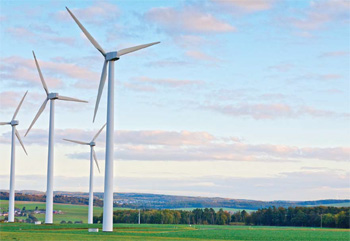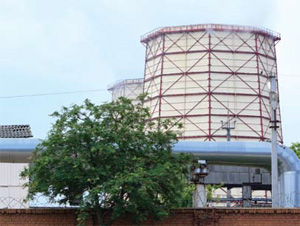Emphasising that TIAC system has an edge over gas turbines, Paul Saville explains the ramifications of how the technology works.
Emphasising that TIAC system has an edge over gas turbines, Paul Saville explains the ramifications of how the technology works.
THE BACKGROUND
Turbine Inlet Air Cooling (TIAC) is an established and proven technology to enhance gas turbine generator power output and efficiency. The application of TIAC, however, is complex, as there are many variables to consider.
Owners in the Middle East typically utilise the services of consultants, such as in the district cooling market to assist them in evaluating energy solutions before issuing Requests for Proposal (RFPs) to Engineering Procurement and Construction (EPC) companies. But until now, the field of TIAC does not appear to have the benefit of the services of consultants.
 TIAC has been applied globally to hundreds of gas turbines, and the Kingdom of Saudi Arabia accounts for most applications in the Middle East. The power output of an existing gas turbine can be increased by up to 30% during the summer months when the ambient temperature is very high, with additional benefit of improved heat rate, or fuel efficiency. TIAC can provide a ‘virtual turbine’, which can be turned on quickly to provide an almost instantaneous boost in power output. However, many applications are not cost efficient, as the plants are designed for ambient conditions, which either do not exist or do so only for a few hours per year. This can result in plants which could be 20% or more oversized and over cost. The result is that many otherwise viable TIAC projects are shelved due to higher than necessary capital costs.
TIAC has been applied globally to hundreds of gas turbines, and the Kingdom of Saudi Arabia accounts for most applications in the Middle East. The power output of an existing gas turbine can be increased by up to 30% during the summer months when the ambient temperature is very high, with additional benefit of improved heat rate, or fuel efficiency. TIAC can provide a ‘virtual turbine’, which can be turned on quickly to provide an almost instantaneous boost in power output. However, many applications are not cost efficient, as the plants are designed for ambient conditions, which either do not exist or do so only for a few hours per year. This can result in plants which could be 20% or more oversized and over cost. The result is that many otherwise viable TIAC projects are shelved due to higher than necessary capital costs.
There are many issues to consider when selecting a TIAC system for a gas turbine, other than the very important selection of design ambient condition. A few of these are:
There are, of course, several other requirements to be considered, which demand expertise and experience in the field to evaluate and find the optimum system for the client. In this context, TIAC is considerably less expensive than a gas turbine, can be installed in much less time, and has the additional benefit of improved heat rate and reduced carbon footprint.
AN INSIGHT INTO TIAC
Why cool the air?
 Gas turbines are constant volume machines, but their performance is dependent on mass flow rate. As the ambient temperature increases, the mass flow rate and power output decrease. Applying TIAC eliminates most of this power degradation.
Gas turbines are constant volume machines, but their performance is dependent on mass flow rate. As the ambient temperature increases, the mass flow rate and power output decrease. Applying TIAC eliminates most of this power degradation.
What are the methods available?
Evaporative cooling and fogging systems are limited by ambient wet bulb and cannot cool the air below an approach to wet bulb. They are also not completely controllable. On the other hand, mechanical TIAC systems are not limited by wet bulb, and are capable of controlling to a constant turbine inlet air temperature.
How does mechanical TIAC work?
A cooling coil is installed in the gas turbine filter house, through which is passed a cooling fluid such as chilled water, glycol, or sometimes a direct refrigerant. Some variants have a hybrid evaporative/mechanical cooler installed in front of the filter house, which can provide ‘free’ cooling to certain temperatures, and mechanical cooling when a lower temperature and higher power output is required. These evaporative/mechanical cooler systems have the additional benefit of pre-filtration of the air.
FILTER HOUSES
The filter house is the interface with the gas turbine and it is critical that it is designed correctly, and is compatible with coils, to prevent water carryover and potential damage to the gas turbine. This will involve careful review of air velocities and mist eliminator design.
Some filter houses, particularly on existing installations, are not ‘coil ready’ and therefore have to be modified to accommodate cooling coils. It is, therefore, preferable for new installations to have coil-ready filter houses, even if TIAC is not being applied immediately, as the cost increase is marginal compared with the later retrofit cost.
AVAILABLE TECHNOLOGIES
There are many mechanical cooling systems available to provide chilled water or glycol to TIAC coils, like centrifugal chillers, compound centrifugal chillers, screw chillers, and absorption chillers. The selection of these chillers is dependent on design ambient conditions, water availability, and available energy to drive the chillers.
Absorption chillers can utilise waste heat from the gas turbine exhaust system to provide an energy source (steam or air) to drive absorption chillers. Although these chillers have a higher capital cost, and can only be applied to certain TIAC systems, they are efficient and provide a lower operating cost.
THERMAL ENERGY STORAGE (TES)
Chilled water or ice thermal storage tanks can significantly reduce the capital cost of TIAC systems in certain applications. These can be utilised as either a full or partial storage mode depending on the application and a client’s requirements. TES systems can also maximise the peak power enhancement, although the plant footprint will increase.
SUMMARY
TIAC is a very important technology in the present climate of increased power demand. It is a proven technology, which can be applied quickly and at a relatively low cost, improves energy efficiency and reduces the carbon footprint. The application of TIAC is a complex issue, with many variables to be considered. These require expertise and experience to apply correctly, safely, and cost effectively.
The author is Managing Director of Saville Energy Consultancy. He may be contacted at paul@saville-energy.com or visit www.saville-energy.com
Copyright © 2006-2025 - CPI Industry. All rights reserved.